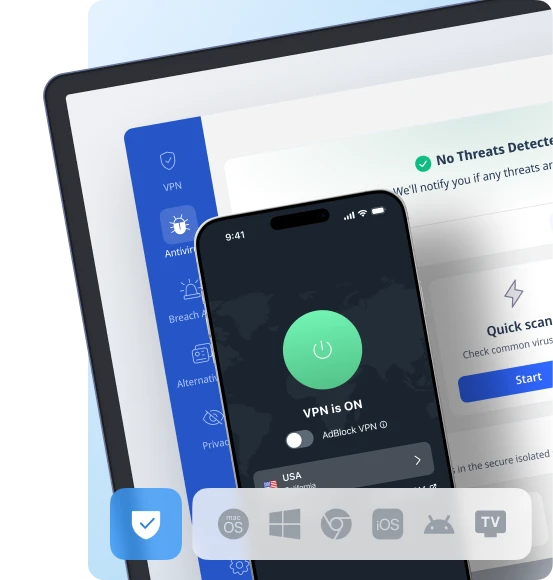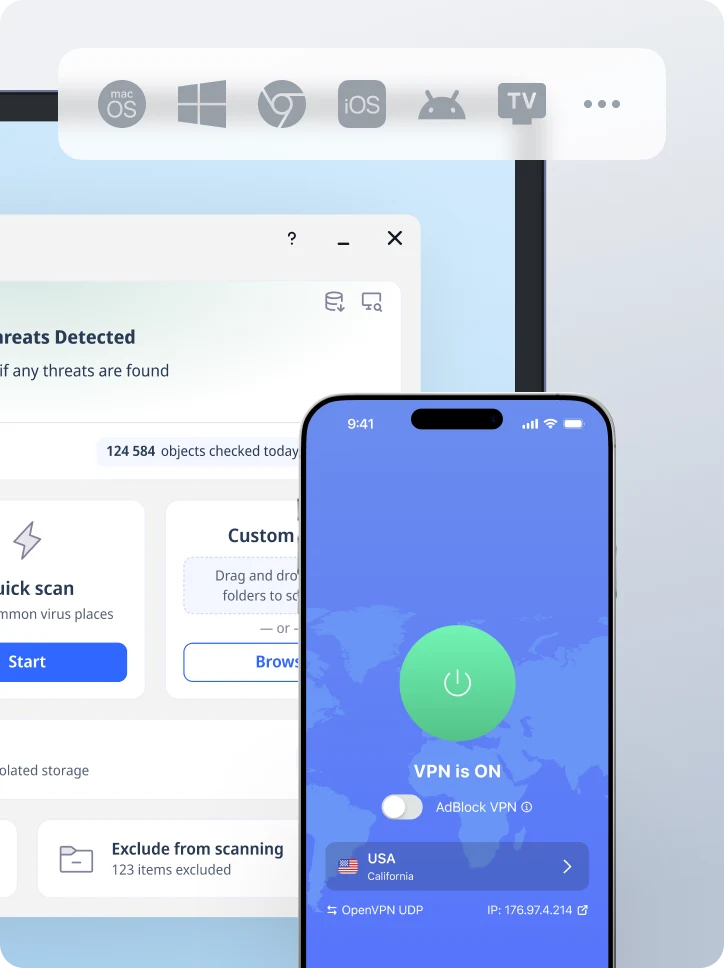SSL VPN: What It Is, Portal vs Tunnel, and When to Use It
Opening a secure session from a hotel, airport lounge, or home office shouldn’t feel like launching a space shuttle. A SSL VPN lets remote users reach a corporate network through a familiar web browser, riding the same HTTPS channel you use to check email or banking. That simplicity made SSL/TLS‑based remote access explode alongside hybrid work.
In this article we’ll break down how SSL VPNs operate, the difference between a SSL portal VPN and a SSL tunnel VPN, how they compare with an IPsec VPN, where attackers have recently gone after edge appliances, and how a modern service like VeePN can extend protection across all your traffic.

What is an SSL VPN?
A SSL VPN (Secure Sockets Layer virtual private network) uses TLS (the successor to the old secure sockets layer) to form an encrypted connection between a user’s device and an SSL VPN gateway (or VPN gateway) sitting in front of the organization’s network.
- You authenticate (often through Multi-Factor Authentication)
- The gateway verifies its certificate
- An SSL VPN connection stands up so you can gain access to selected network resources over the Internet.
Because it leverages HTTPS, most deployments work in standard web browsers on any operating system without heavy installs.
How SSL VPN work (basic flow)
- You browse to the portal URL
- Your browser negotiates the TLS handshake (that’s the SSL protocol legacy label) with the VPN server.
- After credentials, certificates, or tokens confirm you’re an authenticated user, the device builds an encrypted tunnel (scope depends on mode).
- Approved traffic becomes SSL traffic and travels safely across public networks, protecting sensitive data in transit.
- The gateway proxies that traffic into the secure network so you can hit apps, file shares, or other private network services.
- Session closes. Then keys expire, and you need to log back in next time.
But not all SSL setups are alike. Some only front a menu of web apps; others extend deeper, steering additional protocols into the tunnel. Knowing which one you deploy helps you set user expectations and security boundaries.
SSL portal VPN (clientless, scoped access)
A SSL portal VPN (sometimes called clientless) gives you a login VPN portal page. From that single screen, you click approved links to email, HR, ticketing, or other web resources and web based applications. Everything rides one single SSL connection between browser and gateway, which keeps exposure small and the learning curve light.
The downside is that portal mode generally protects browser sessions only, and anything outside the browser (backup agents, VoIP apps) is out of scope, so you do not see the entire network.
SSL tunnel VPN (broader reach, helper needed)
A SSL tunnel VPN expands coverage. After browser authentication, lightweight specialized client software or browser‑launched active content spins up a local adapter that funnels multiple network services (RDP to an internal computer, SMB, VoIP) into the SSL VPN tunnel. This feels closer to a full VPN tunnel, but adds components to manage and patch.
Need to say here that browser convenience isn’t the only model. Many enterprises still rely on IPsec VPN technology for device‑wide tunnels. Let’s see how the two approaches differ so you can pick the right tool per user group.
SSL VPN vs IPsec VPN
An IPsec VPN uses Internet protocol security (the IPsec VPN protocol) at the network layer to encrypt all packets between endpoints. Once connected, users often see the whole address space and full network services, which is powerful but can overshare.
By contrast, an SSL VPN creates HTTPS‑wrapped sessions above the transport layer, so admins can publish only what’s required and maintain tighter granular control.
Another trade‑off: most IPsec VPN solutions need dedicated client software on every device, while many SSL deployments work in most modern web browsers, easing rollout. Performance for bulk network traffic can favor IPsec. But ease and selective secure access tilt SSL.
When to keep IPsec?
Choose IPsec for site‑to‑site links, always‑on laptops, or use cases that require full routing to internal network utilities and voice/video QoS. Large data transfers and legacy apps that demand raw layer‑3 reach still play better over IPsec.
When to enable SSL VPN?
Pick SSL/TLS for contractors, BYOD, or task‑specific secure remote access where users only need a few apps. You’ll reduce blast radius, simplify onboarding, and dodge heavyweight rollouts across diverse devices in a dispersed remote workforce.
Whether portal or tunnel, a few moving parts decide stability and security: the gateway appliance, browser compatibility, and any helper agent. Keep each clean and patched.
Key components of an SSL deployment
- SSL VPN gateway hardware or VM fronts the internet, terminates TLS, and brokers traffic into the corporate network. Harden it like any edge firewall.
- Browser support matters. Some older builds choke on required active content (Java, JS helpers) used by SSL tunnel VPN features; test across modern web browsers before rollout.
- Lightweight agents. Even “clientless” portals sometimes drop a mini‑agent to map drives or launch RDP. Track versions; unpatched client software can be hijacked.
Recent SSL VPN security incidents to learn from them
- Ivanti CVE‑2025‑0282/0283. Disclosed January 8, 2025; Mandiant found cyber criminals and espionage actors exploiting 0282 in the wild weeks earlier, allowing unauthenticated code execution on exposed appliances. Patch and run integrity checks.
- Ivanti CVE‑2025‑22457. Announced April 4, 2025. Active exploitation produced remote code execution against older builds even after a February patch. Threat actors likely diffused the fix to craft exploits. Proof that delayed upgrades invite repeat hits.
- Fortinet post‑exploitation & symlink abuse. April 11, 2025 advisories and follow‑on reporting showed attackers leaving malicious symlinks in SSL-VPN language file paths to retain read‑only access even after patching; CISA urged credential resets and, if needed, disabling SSL‑VPN temporarily.
Having that said, let’s see how to secure an access.
Best practices to secure access
- Publish only needed apps. Don’t bridge the entire network unless business demands it. Least privilege reduces damage if accounts are phished.
- Enforce MFA everywhere you enable SSL VPN. Stolen passwords remain a top intrusion vector on edge boxes.
- Patch the gateway fast. Recent Ivanti and Fortinet waves show attackers racing patches. Track CVEs and follow vendor emergency guidance.
- Monitor logs for abnormal SSL traffic spikes or repeated failures from new geos; these often precede exploitation attempts.
- Educate users to log out on shared machines and verify certificate warnings. Sloppy kiosk use can backdoor the corporate network.
VeePN: a modern alternative to traditional SSL VPN deployments
Classic SSL portals are great for quick wins but stop at the browser edge. VeePN wraps every app on every device, adds threat blocking, and scales globally. It is useful when you have mixed needs across contractors, travelers, and full‑time staff.
- AES-256 encryption. VeePN secures all traffic, not just portal sessions, protecting sensitive data on hotel Wi‑Fi and enterprise links alike; strong encryption is a core control in modern remote‑access security frameworks.
- No Logs policy. Many gateways log session details for audit and become targets. VeePN’s strict No Logs stance helps reduce data exposure should infrastructure be compromised.
- Cross-platform support. Install once and cover Windows, macOS, iOS, Android, Linux, and browser extensions, which is ideal when your remote users mix personal and work gear.
- 2,500+ servers in 89 locations. Global reach keeps latency low and avoids choke points common on undersized on‑prem appliances, helping maintain responsive secure connections.
- Kill Switch for leak protection. If the tunnel drops, traffic stops. This closes one of the common gaps in mixed SSL/IPsec stacks where brief leaks expose your real IPs.
- NetGuard threat blocker. VeePN’s built‑in filtering strips malicious domains and trackers that slip in when users bounce between portal links and open tabs.
- Secure on public Wi-Fi. Full‑device coverage means apps outside the browser stay encrypted, unlike a strict portal‑only SSL VPN workflow. That’s vital for travel days and café sessions.
Try VeePN risk‑free as we offer a 30-day money-back guarantee.
FAQ
It’s a browser‑friendly SSL VPN that uses TLS (the updated secure sockets layer) to form an encrypted connection from your device to an SSL VPN gateway, letting you reach internal apps over the internet with just a browser. Discover more details in this article.
People often call full device tunnels a “normal VPN” (think IPsec VPN). Those encrypt all traffic at the network layer. An SSL VPN usually scopes access to selected apps through HTTPS, needs less setup, and is easier for contractors but may not cover background traffic. Discover more details in this article.
Vendors label “Global” clients (like some enterprise suites) when they combine browser portals with full‑tunnel capability. A standalone SSL portal VPN typically limits you to published apps, while a “Global” or hybrid client can steer system‑wide flows similar to IPsec. Discover more details in this article.
Portal mode may cover only web based applications, leaving other traffic exposed. Helper plug‑ins can break, and unpatched appliances have been heavily exploited (Ivanti, Fortinet). Always patch fast and restrict access. Discover more details in this article.
VeePN is freedom
Download VeePN Client for All Platforms
Enjoy a smooth VPN experience anywhere, anytime. No matter the device you have — phone or laptop, tablet or router — VeePN’s next-gen data protection and ultra-fast speeds will cover all of them.
Download for PC Download for Mac IOS and Android App
IOS and Android App
Want secure browsing while reading this?
See the difference for yourself - Try VeePN PRO for 3-days for $1, no risk, no pressure.
Start My $1 TrialThen VeePN PRO 1-year plan







